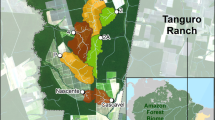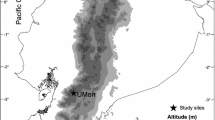Abstract
Land use changes have resulted in large environmental impacts, and in agricultural landscapes sometimes only forest fragments remain. Riparian forest remnants can positively influence stream water quality, and serve as refuges for aquatic species. We evaluated whether the presence of a riparian forest remnant influenced the structure and composition of macroinvertebrate communities in a rural stream in southeastern Brazil. We sampled three reaches upstream (within abandoned sugarcane cultivation) and nine downstream the remnant edge, until 600 m inside the forested area, using leaf litter bags. The abundances of Elmidae, Chironomidae, and total macroinvertebrates increased along the forest remnant, whereas the abundance of Baetidae, proportion of Ephemeroptera, Plecoptera, and Trichoptera (EPT), rarefied taxonomic richness, and diversity decreased. Taxon richness and EPT abundance did not vary along the forest remnant. Increases in Chironomidae and total abundance within the forest remnant can be related to moderate increases in nutrient concentrations, or to the availability of high quality leaf litter patches. Forest remnants can influence macroinvertebrate communities, although variation both in temperate and tropical studies can be related to local agricultural practices and land use at the watershed scale. Forest remnants are important in maintaining stream water quality in rural landscapes, and deserve attention in watershed management projects.




Similar content being viewed by others
References
Allan, J. D., 2004. Landscapes and riverscapes: the influence of land use on stream ecosystems. Annual Review of Ecology, Evolution and Systematics 35: 257–284.
Arnaiz, O. L., A. L. Wilson, R. J. Watts & M. M. Stevens, 2011. Influence of riparian condition on aquatic macroinvertebrate communities in an agricultural catchment in south-eastern Australia. Ecological Research 26: 123–131.
Boyero, L., A. Ramírez, D. Dudgeon & R. G. Pearson, 2009. Are tropical streams really different? Journal of the North American Benthological Society 28: 397–403.
Chakona, A., C. Phiri, T. Chinamaringa & N. Muller, 2009. Changes in biota along a dry-land river in northwestern Zimbabwe: declines and improvements in river health related to land use. Aquatic Ecology 43: 1095–1106.
Chao, A. & T. J. Shen, 2003. Nonparametric estimation of Shannon’s index of diversity when there are unseen species in sample. Environmental and Ecological Statistics 10: 429–443.
Chao, A. & T. J. Shen, 2010. Program SPADE (Species Prediction And Diversity Estimation). Program and User’s Guide published at http://chao.stat.nthu.edu.tw.
Clarke, K. R., 1993. Non-parametric multivariate analysis of changes in community structure. Australian Journal of Ecology 18: 117–143.
Clarke, K. R. & R. N. Gorley, 2006. PRIMER v6: User Manual/Tutorial. PRIMER-E, Plymouth.
Corbi, J. J. & S. Trivinho-Strixino, 2008. Relationship between sugar cane cultivation and stream macroinvertebrate communities. Brazilian Archives of Biology and Technology 51: 769–779.
Cummins, K. W., 1974. Structure and function of stream ecosystems. BioScience 24: 631–641.
Cummins, K. W., R. W. Merritt & P. C. N. Andrade, 2005. The use of invertebrate functional groups to characterize ecosystem attributes in selected streams and rivers in south Brazil. Studies on Neotropical Fauna and Environment 40: 69–89.
Dudgeon, D. & B. W. Gao, 2011. The influence of macroinvertebrate shredders, leaf type and composition on litter breakdown in a Hong Kong stream. Fundamental and Applied Limnology 178: 147–157.
Fahrig, L., 2003. Effects of habitat fragmentation on biodiversity. Annual Review of Ecology, Evolution, and Systematics 34: 487–515.
Fonseca, D. G., 2011. Efeitos da presença de macrófitas nos macroinvertebrados de córregos tropicais. MSc Dissertation, Universidade Federal de São Carlos, São Carlos.
Gotelli, N. & R. K. Colwell, 2001. Quantifying biodiversity: procedures and pitfalls in the measurement and comparison of species richness. Ecology Letters 4: 379–391.
Graça, M. A. S., 2001. The role of invertebrates on leaf litter decomposition in streams – a review. International Review of Hydrobiology 86: 383–393.
Harding, J. S., K. Claassen & N. Evers, 2006. Can forest fragments reset physical and water quality conditions in agricultural catchments and act as refugia for forest stream invertebrates? Hydrobiologia 568: 391–402.
Hepp, L. U. & S. Santos, 2009. Benthic communities of streams related to different land uses in a hydrographic basin in southern Brazil. Environmental Monitoring and Assessment 157: 305–318.
Janke, H. & S. Trivinho-Strixino, 2007. Colonization of leaf litter by aquatic macroinvertebrates: a study in a low order tropical stream. Acta Limnologica Brasiliensia 19: 109–115.
Kikuchi, R. M. & V. S. Uieda, 2005. Composição e distribuição dos macroinvertebrados em diferentes substratos de fundo de um riacho no município de Itatinga, São Paulo, Brasil. Entomología y Vectores 12: 193–231.
Korman, V., 2003. Proposta de interligação das glebas do Parque Estadual de Vassununga (Santa Rita do Passa Quatro, SP). Dissertação de Mestrado, Universidade de São Paulo, Piracicaba.
Li, A. O. Y. & D. Dudgeon, 2009. Shredders: species richness, abundance, and role in litter breakdown in tropical Hong Kong streams. Journal of the North American Benthological Society 28: 167–180.
Maloney, K. O., D. E. Weller, M. J. Russell & T. Hothorn, 2009. Classifying the biological condition of small streams: an example using benthic macroinvertebrates. Journal of the North American Benthological Society 28: 869–884.
Martinelli, L. A. & S. Filoso, 2008. Expansion of sugarcane ethanol production in Brazil: environmental and social challenges. Ecological Applications 18: 885–898.
Martins, F. R., 1991. Estrutura de uma floresta mesófila. Série Teses. Editora da UNICAMP (Campinas).
Menninger, H. L. & M. A. Palmer, 2007. Herbs and grasses as allochthonous resource in open-canopy headwater streams. Freshwater Biology 52: 1689–1699.
Morais, M., P. Pinto, P. Guilherme, J. Rosado & I. Antunes, 2004. Assessment of temporary streams: the robustness of metric and multimetric indices under different hydrological conditions. Hydrobiologia 516: 229–249.
Mykrä, H., J. Heino & T. Muotka, 2007. Scale-related patterns in the spatial and environmental components of stream macroinvertebrate assemblage variation. Global Ecology and Biogeography 16: 149–159.
Naiman, R. J., H. Décamps & M. E. McClain, 2005. Riparia – Ecology, Conservation, and Management of Streamside Communities. Elsevier, Amsterdam.
Nessimian, J. L., E. M. Venticinque, J. Zuanon, P. De Marco Jr, M. Gordo, L. Fidelis, J. D. Batista & L. Juen, 2008. Land use, habitat integrity, and aquatic insect assemblages in Central Amazonian streams. Hydrobiologia 614: 117–131.
Odum, E. P., J. T. Finn & E. H. Franz, 1979. Perturbation theory and the subsidy-stress gradient. Bioscience 29: 349–352.
Ometo, J. P. H. B., L. A. Martinelli, M. V. Ballestery, A. Gessner, A. V. Krusche, R. L. Victoria & M. Williams, 2000. Effects of land use on water chemistry and macroinvertebrates in two streams of the Piracicaba river basin, south-east Brazil. Freshwater Biology 44: 327–337.
Ortiz, J. D. M. & A. Puig, 2007. Point source effects on density, biomass and diversity of benthic macroinvertebrates in a mediterranean stream. River Research and Applications 23: 155–170.
Palmer, M. A., C. M. Swan, K. Nelson, P. Silver & R. Alvestad, 2000. Streambed landscapes: evidence that stream invertebrates respond to the type and spatial arrangement of patches. Landscape Ecology 15: 563–576.
Pivello, V. R. & E. M. Varanda, 2005. O cerrado Pé-de-Gigante: ecologia e conservação. SMA, São Paulo.
Quinn, J. M., A. B. Cooper, R. J. Davies-Colley, J. C. Rutherford & R. B. Williamson, 1997. Land use effects on habitat, water quality, periphyton, and benthic invertebrates in Waikato, New Zealand, hill-country streams. New Zealand Journal of Marine and Freshwater Research 31: 579–597.
Robinson, G. R., R. D. Holt, M. S. Gaines, S. P. Hamburg, M. L. Johnson, H. S. Fitch & E. A. Martinko, 1992. Diverse and contrasting effects of habitat fragmentation. Science 257: 524–526.
Rosenberg, D. M. & V. H. Resh, 1993. Freshwater biomonitoring and benthic macroinvertebrates. Chapman & Hall, New York.
Saunders, D. A., R. J. Hobbs & C. R. Margules, 1991. Biological consequences of ecosystem fragmentation: a review. Conservation Biology 5: 18–32.
Scarsbrook, M. R. & J. Halliday, 1999. Transition from pasture to native forest land-use along stream continua: effects on stream ecosystems and implications for restoration. New Zealand Journal of Marine & Freshwater Research 33: 293–310.
Setzer, J., 1966. Atlas climatológico do Estado de São Paulo. Comissão Interestadual da Bacia do Paraná-Paraguai, CESP, São Paulo.
Shortle, J. S., D. G. Abler & M. Ribaudo, 2001. Agriculture and water quality: the issues. In Environmental Policies for Agricultural Pollution Control. CABI Publishing, London: 1–18.
Silver, P., D. Wooster & M. A. Palmer, 2004. Chironomid responses to spatially structured, dynamics, streambed landscapes. Journal of the North American Benthological Society 23: 69–77.
Smith, G. C., A. P. Covich & A. M. D. Brasher, 2003. An ecological perspective on the biodiversity of tropical island streams. BioScience 53: 1048–1051.
Sponseller, R. A., E. F. Benfield & H. M. Valett, 2001. Relationships between land use, spatial scale and stream macroinvertebrate communities. Freshwater Biology 46: 1409–1424.
Storey, R. G. & D. R. Cowley, 1997. Recovery of three New Zealand rural streams as they pass through native forest remnants. Hydrobiologia 353: 63–76.
Thompson, R. M. & C. R. Townsend, 2004. Land-use influences on New Zealand stream communities: effects on species composition, functional organization, and food-web structure. New Zealand Journal of Marine and Freshwater Research 38: 595–608.
Townsend, C. R., C. J. Arbuckle, T. A. Crowl & M. R. Scarsbrook, 1997. The relationship between land use and psycochemistry, food resources and macroinvertebrate communities in tributaries of the Taieri River, New Zealand: a hierarchically scaled approach. Freshwater Biology 37: 177–191.
Valderrama, J. C., 1981. The simultaneous analysis of total nitrogen and phosphorus in natural waters. Marine Chemistry 10: 109–122.
Vannote, R. L., G. W. Minshall, K. W. Cummins, J. R. Sedell & C. E. Cushing, 1980. The River Continuum Concept. Canadian Journal of Fisheries and Aquatic Sciences 37: 130–137.
Ward, J. V., 1992. Aquatic Insect Ecology: Biology and Habitat. Wiley, New York.
Ward, J. V. & K. Tockner, 2001. Biodiversity: towards a unifying theme for river ecology. Freshwater Biology 46: 807–819.
Zwick, P., 1992. Stream habitat fragmentation – a threat to biodiversity. Biodiversity and Conservation 1: 80–97.
Acknowledgments
We thank all the people who helped in the field work, especially F.Y. Hanai, J.F. Fernandes and L.A. Joaquim, A.L.T. Souza for help in planning the sampling design and data analyses, Heverton J. Ribeiro—Manager of Parque Estadual de Vassununga—for support, Conselho Nacional de Desenvolvimento Científico e Tecnológico for financial support (procs. 480181/2010-1, 308630/2010-6), and Coordenação de Aperfeiçoamento de Pessoal de Nível Superior for the scholarship to the first author.
Author information
Authors and Affiliations
Corresponding author
Additional information
Handling editor: David Dudgeon
Rights and permissions
About this article
Cite this article
Suga, C.M., Tanaka, M.O. Influence of a forest remnant on macroinvertebrate communities in a degraded tropical stream. Hydrobiologia 703, 203–213 (2013). https://doi.org/10.1007/s10750-012-1360-1
Received:
Revised:
Accepted:
Published:
Issue Date:
DOI: https://doi.org/10.1007/s10750-012-1360-1




